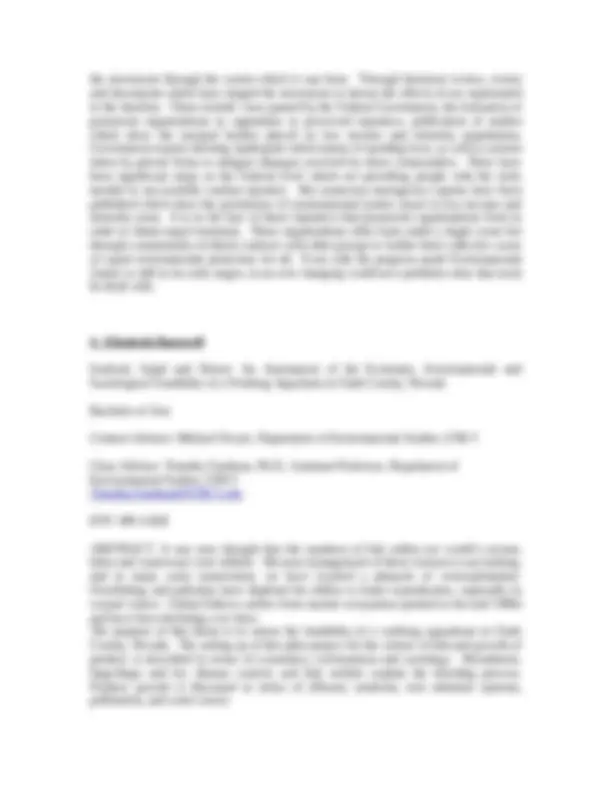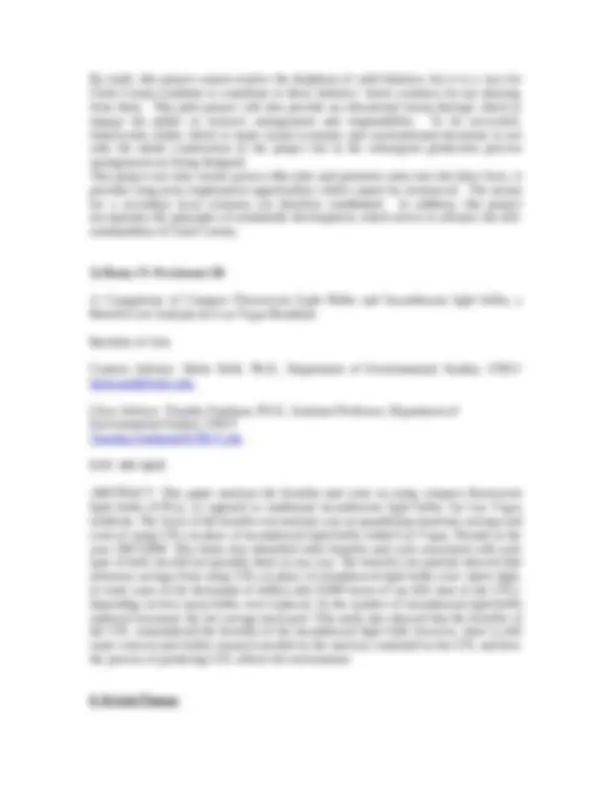





Study with the several resources on Docsity

Earn points by helping other students or get them with a premium plan


Prepare for your exams
Study with the several resources on Docsity

Earn points to download
Earn points by helping other students or get them with a premium plan
Community
Ask the community for help and clear up your study doubts
Discover the best universities in your country according to Docsity users
Free resources
Download our free guides on studying techniques, anxiety management strategies, and thesis advice from Docsity tutors
Various senior projects in the field of environmental studies at the university of nevada, las vegas (unlv). The projects cover a range of topics including photovoltaic systems, cultural and ecological restoration, environmental justice, aquafarm in nevada, light bulbs benefit-cost analysis, life cycle analysis of cotton t-shirts, controlling pm10 emissions, residential grey water systems, and more. The projects were completed by students as part of their bachelor of arts or bachelor of science degrees, with guidance from unlv faculty.
Typology: Papers
1 / 7

This page cannot be seen from the preview
Don't miss anything!




1. Ashley Rosia Utilizing a Grid-Tied Photovoltaic System for Average Energy Use in a Southern Nevada Area Home Bachelor of Science Content Advisor: Helen Neill, Ph.D., Department of Environmental Studies, UNLV helen.neill@unlv.edu, Class Advisor: Timothy Farnham, Ph.D., Assistant Professor, Department of Environmental Studies, UNLV Timothy.Farnham@UNLV.edu ENV 499 A &B ABSTRACT: This study will show a cost analysis of the three main types of photovoltaic arrays in use today. It will give in detail the cost and savings that will be given to the consumer who utilizes a photovoltaic array that is still connected to the grid. This study will also reflect the current incentives offered by the Nevada Power company to help offset some of the costs to installing a solar power system, also it will show the credit system in use by Nevada Power when a household releases energy back onto the grid. Assumptions about energy rate increases, and inflation will also be included into the overall cost analysis. 2. Caroline Baker - Nair Cultural and Ecological Restoration; A Survey of Relationships Between the Timbisha Shoshone Tribe, Western Honey Mesquite and Single-Leaf Pinyon Pine in Death Valley National Park Bachelor of Arts Content Advisor: Robert Futrell, Department of Sociology, UNLV Class Advisor: Timothy Farnham, Ph.D., Assistant Professor, Department of Environmental Studies, UNLV Timothy.Farnham@UNLV.edu ENV 499 A &B ABSTRACT: Many ecological restoration projects now follow multidisciplinary approaches for long-term integrated restoration of ecosystems and, consequently,
revitalize both the local environment and their intertwined human communities. Ethnobotany is often used as the mediator to connect cultural (community) values, knowledge and traditional practices with scientific methods and applications. A study produced by an ethnobotanist and several members of the Timbisha Shoshone Tribe (TST) expresses concern over long-term survival and health of Western Honey Mesquite (Prosopis glandulosa var. torreyana) and Single-Leaf Pinyon Pine (Pinus monophylla) populations within Death Valley National Park. Their concern surrounds possible health impacts to the trees because of the lack of the TST’s traditional practices of harvesting, pruning, and clearing of underbrush surrounding the plants. Historically, these practices were prohibited by the National Park Service shortly after the national monuments creation (1933) until the early 1990’s when the tribe was granted permission to harvest and manage the trees. The study identified several other possible reasons for declining tree health, which include the diversion of water flows away from mesquite groves, concessionaire use of water resources, invasive plant species, and insect predation. The purpose of this study is to examine attitudes, perceptions, and interests of the TST about their current and historical relationships with western honey mesquites and single- leaf pinyon pines within Death Valley National Park. Understanding the current and historical relationships between the people who have lived with and cared for the trees in this region may provide useful knowledge and insight for restoration practitioners. Inclusion of tribe interests, practices and knowledge into land management and ecological restoration plans may increase the chances of success for long-term survival of mesquite and pinyon pine communities within the national park. Additionally, involving the TST in restoration and management efforts could help them to restore traditional land management practices and preserve their cultural values.
3. Charles Keh Environmental Justice in the United States Bachelor of Arts Content Advisor: Timothy Farnham, Ph.D., Assistant Professor, Department of Environmental Studies, UNLV Timothy.Farnham@UNLV.edu Class Advisor: Timothy Farnham, Ph.D., Assistant Professor, Department of Environmental Studies, UNLV Timothy.Farnham@UNLV.edu ENV 499 A &B ABSTRACT: Over time the environmental justice movement it has used terms such as "Environmental Racism" and "Environmental Equity" before setting upon the more widely used and generally inclusive term of “Environmental Justice.” This study follows
By itself, this project cannot resolve the depletion of wild fisheries, but it is a way for Clark County residents to contribute to these fisheries’ future existence by not drawing from them. This pilot project will also provide an educational forum through which to engage the public in resource management and responsibility. To be successful, frameworks within which to make sound economic and environmental decisions in not only the initial construction of the project but in the subsequent production process management are being designed. This project not only creates green-collar jobs and promotes entry into the labor force, it provides long-term employment opportunities which cannot be outsourced. The means for a secondary local economy are therefore established. In addition, this project incorporates the principles of sustainable development, which serves to advance the self- sustainability of Clark County. 5) Henry N. Weckesser III A Comparison of Compact Fluorescent Light Bulbs and Incandescent light bulbs, a Benefit-Cost Analysis for Las Vegas Residents Bachelor of Arts Content Advisor: Helen Neill, Ph.D., Department of Environmental Studies, UNLV helen.neill@unlv.edu, Class Advisor: Timothy Farnham, Ph.D., Assistant Professor, Department of Environmental Studies, UNLV Timothy.Farnham@UNLV.edu ENV 499 A&B ABSTRACT: This paper analyses the benefits and costs on using compact fluorescent light bulbs (CFLs), as opposed to traditional incandescent light bulbs, for Las Vegas residents. The focus of the benefit-cost analysis was on quantifying monetary savings and costs of using CFLs in place of incandescent light bulbs within Las Vegas, Nevada in the year 2007/2008. This study also identified other benefits and costs associated with each type of bulb, but did not quantify them in any way. The benefit-cost analysis showed that monetary savings from using CFLs in place of incandescent light bulbs were where high, in some cases in the thousands of dollars after 8,000 hours of use (life time of the CFL), depending on how many bulbs were replaced. As the number of incandescent light bulbs replaced increased, the net savings increased. This study also showed that the benefits of the CFL outnumbered the benefits of the incandescent light bulb; however, there is still some concern and further research needed on the mercury contained in the CFL and how the process of producing CFL affects the environment.
6. Kristie Pitman
A Qualitative Life Cycle Analysis of Cotton T-Shirts: from Agriculture to the Landfill Bachelor of Arts Content Advisor: Robert Futrell, Department of Sociology, UNLV Class Advisor: Timothy Farnham, Ph.D., Assistant Professor, Department of Environmental Studies, UNLV Timothy.Farnham@UNLV.edu ENV 499 A &B ABSTRACT: Millions of people purchase clothing regularly and dispose of it when it is no longer desired or in good condition. Many of these same people do not consider the environmental impacts that are associated with the making and usage of the product. This paper is a qualitative life cycle analysis of 100% cotton t-shirts. The specific goal is to understand the environmental impacts involved in their production and use. This involves examining the various stages including the extraction of the materials including the growing and harvesting of cotton; the processing of the materials, including the ginning, spinning and the weaving; the production of the t-shirt, including sewing, dyeing or bleaching; the use and maintenance of the t-shirt; and the disposal of the t-shirt. The main question to be answered is what are the ecological impacts that are produced in the life cycle of cotton t-shirts? Several sub questions will also be discussed regarding resource usage, the effects on other ecosystems due to pesticide usage and the transporting of cotton as an import/export commodity, and what the social impacts are. In conclusion, it is shown that cotton is a very resource intensive crop. It uses vast amounts of water, it degrades soil and releases PM10 emissions into the air. There are numerous global impacts caused by the current system discussed including contributions to global warming, ozone depletion, risks to human and animal life, and resource depletion. There are alternative ways that the current system could change to including keeping cotton grown in the U.S. in-house for manufacturing which would cause a huge reduction in unnecessary transportation; stricter recycling laws could be put into place that requires the recycling of clothing which could bring in a bigger industry of turning recycled clothes into new products such as handbags or rags; lastly, consumers need to be educated on the current system and how destructive it is which would hopefully cause people to extend the life of their clothing and buy less of it. Lastly, a few other alternatives to industrial cotton are discussed, including organic cotton and hemp. When compared to industrial cotton, organic cotton and hemp are a lot less environmentally destructive and are viable alternatives.
7. Leah Hare Effectiveness of the Methods Used to Control PM10 in the Owens Dry Lake Bed
ABSTRACT: Residential grey water reuse has the potential to safely reduce household non-potable water consumption. This study is a qualitative comparison on the advantages and disadvantages of three different residential greywater systems for potential use in Southern Nevada. The study compared the following greywater systems that are being used within the United States and Australia to determine if the advantages prevail over the disadvantages. Each of the systems compared utilized greywater differently. The first system utilizes greywater for outdoor reuse only, the second system utilizes greywater for both indoor and outdoor reuse with disinfection capabilities, and the third system utilizes greywater for only indoor toilet tank reuse. Technically, each system would reduce household potable water consumption safely and efficiently. However, Since Southern Nevada has a unique water treatment system, where all wastewater is treated and returned to Lake Mead in the form of return-flow credits and can be withdrawn again; it may be difficult, and risky, to incorporate residential greywater systems as a conservation strategy. It was concluded, the greatest benefit to conserve water by using greywater in a residential application, would come from existing homes that discharged waste water into a septic tank, and homes in the designing, planning, and construction stages that would utilize the greywater technology for indoor non-potable water fixtures, such as toilet tanks. This type of application would reduce household indoor water demand and still provide wastewater supply for return-flow credits.